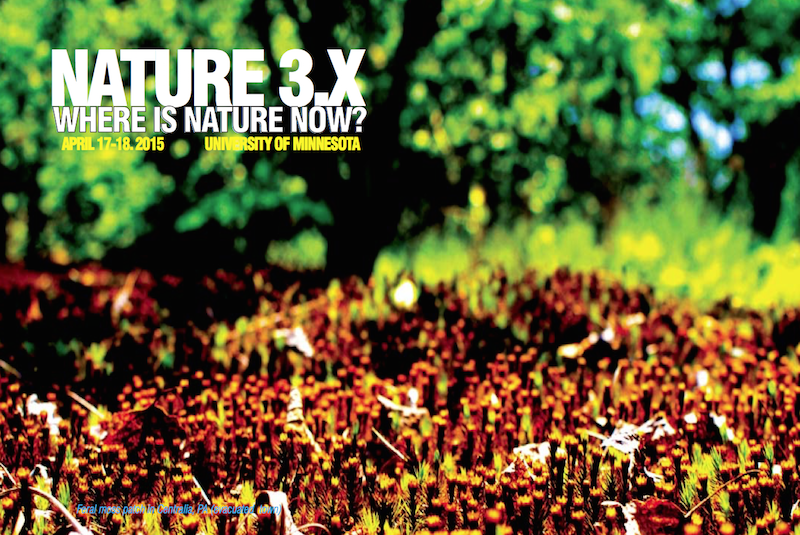In creating Nature 3.x: Where is Nature Now?, symposium co-conveners and University of Minnesota professors Matt Tucker and Christine Baeumler put seven extraordinary thinkers, doers, and creators into relationship around landscape and environment.
In the second of our two-part interview series with Tucker, he sheds light on the special capacity these diverse presenters have for bringing complex concepts down to earth. For insights into why the symposium was created and what participants will get out of it, read part 1 of Tucker’s interview.
(MPF) How did you choose the symposium’s topics and presenters?
(Matt Tucker) The topics reflect landscapes. In the broadest sense, landscapes allow us to consider what we’ve been doing and what new ideas about nature and the environment can arise out of the Anthropocene. There is a lot of really great and interesting work occurring related to this topic, so the challenge wasn’t finding someone to invite, it was how to draw the line. Ultimately we wanted presenters who can get beyond the esoteric- which is incredibly important as we find our way- but who are dealing with the problems and opportunities of our post-natural world on a more visceral level. We also felt it was important to have speakers that can connect with a broad audience.
As far as the speakers themselves, journalist and filmmaker Andrew Blackwell has traveled the world and has experienced and documented some of the most polluted places in the world. These experiences are shared in his book Visit Sunny Chernobyl and Other Adventures in the World’s Most Polluted Places. His boots have walked across the radioactive soil of Chernobyl and he’s smelled the air coming from the tar sand mines of Ft. McMurray, Alberta. In doing so, his work has pulled the curtain back on some of the irony and traps associated with our traditional attitudes towards nature, especially those related to the predominate aesthetics of what is nature and what is not. We simply had to have Andrew visit and share some of his insights from the places where nobody else is looking.
I attended a multidisciplinary conference a few years ago at the University of Delaware and Emma Marris was a keynote speaker. She gave an absolutely fantastic talk about the conflicts and contradictions associated with nature and natural resource management. At that point I thought- well, if I do a symposium in the future I have to invite Emma so others can hear this. Emma is an author that is fluent in both the humanities and the sciences. Because of this she can take on some complex topics about how we see and manage nature through the lens of environmental policy or ecological restoration. I believe her work challenges us to see these the contradictions for what they are and to move past that by thinking in a new way about the larger ecological challenges that lie ahead. Her work has appeared in Nature, the New York Times and her recent book Rambunctious Garden: Saving Nature in a Post-Nature World has stirred a bit of controversy in the way that groundbreaking efforts tend to do.
The work of Works Progress’ co-founders and artists Shanai Matteson and Colin Kloecker is embedded in the nuance of place. In this case, it’s the place and processes found here in Minnesota. A good portion of their work looks beyond some traditional boundaries of what is nature, who controls it and what media is used to represent it. Ultimately, their work allows for new or hidden stories of the everyday world around us to be shared. Just spend a moment on their Vimeo page and you’ll see what I’m talking about. One example of their recent work is that of the “Water Bar”. The Bar is a collaborative public art project that connects community with water through a mobile bar that serves up shot glasses of local tap water with a side order of water knowledge. It also brings community together around water by patrons sharing stories and memories of water. The Water Bar was recently exhibited at the Crystal Bridges Museum of American Art in Arkansas and they will have the Bar set up during the reception this Friday, so I’m sure by night’s end we will have some folks loaded on locally brewed waters!
Kate Orff is a New York based landscape architect and educator who is one of several design thinkers taking on the wicked problems of the 21st century through collaboration and translating new knowledge into practice. Her work operates at several levels, including speculative work at Columbia University’s Urban Landscape Lab as well as the design and planning work of her firm SCAPE//Landscape Architecture. Kate and her team are considering alternative futures for some of the country’s most challenging project sites and environmental issues, such as sea-level rise in the New York City region or environmental justice in Louisiana’s Cancer Alley. The timeliness and foresight of her work is reflected in her recent appointment as the next Director of Columbia University’s GSAPP’s Urban Design Program as well as SCAPE’s Living Breakwaters project winning the 2014 Buckminster Fuller Challenge award for “socially responsible design’s highest award.” We are very fortunate to have her office and design team working on a new future for the Minneapolis riverfront at Water Works park.
For more than three decades Seattle-based artist Buster Simpson has been internationally recognized for asking a different set of questions about our relationship with the environment. In particular, he has been working at the intersection of ecological phenomena, water and public art so as to raise awareness of the world around us. His work is accessible, both physically and conceptually, which provides deep impact. For example, 20 years ago I recall reading about his Host Analog project in Portland, OR and being so excited how it worked on some many different levels in such a simple and profound way. When I took students to see it a few years ago their reaction was the same as mine some twenty years prior and I’m sure students in another 20 years will have the same reaction. One of Buster’s current projects is entitled “Anthropocene Beach” and considers marine and shoreline habitat creation relative to the more immediate context of the modified waterfront but also the long-term context of climate change. The work is part of the multimillion dollar reinvestment in Seattle’s waterfront. We are thrilled to have him as a symposium artist-in-residence, where for several days UMN students will be working directly with Buster on an improvisational pop-up project called “Urban HEADwaters”. We have no idea where the project is heading, but Buster’s asked us to track down water sampling kits and a bilge pump, so it sounds like something a little dangerous and special.
The work of Amsterdam-based Koert vanMensvoort and the Next Nature project is stunning in its prospect, which asserts that “Nature is changing along with us”. His work arises from a landscape- that of the Netherlands- that is entirely human-made. In that way it is not much different than the American Midwest in how it has been altered and managed. However, for Koert this understanding of the created Netherlands landscape has opened some tremendous insight that necessitates looking past traditional separations of nature and society. His work and that of the NextNature project consider how technology, humans and nature are co-evolving. Koert asserts that “we must no longer see ourselves as the anti-natural species that threatens and eliminates nature, but rather as catalysts of evolution.” To that end, some of his recent work includes observations on the evolution of the personal razor (Razorius Gilletus) or the recently published In-Vitro Meat Cookbook. He is joining us fresh off his presentation at this year’s SXSW Festival in Austin, so it remains to be seen if Koert himself evolved and picked up a deep Texas accent and southern slang.
Featured image courtesy of Matt Tucker

